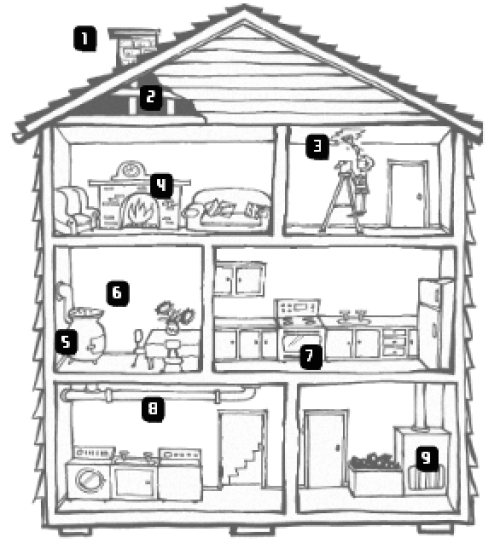Asbestos in the home
Exposure to asbestos in the home
Generally, materials that contain asbestos that are in good condition will not release asbestos fibres. There is no danger unless fibres are released and inhaled into your lungs. If you are not living in a home that contains asbestos, your exposure to asbestos is not likely to present a high level or risk.
How you can be exposed to higher levels of asbestos
You can be exposed to higher levels of airborne asbestos inside your home, than levels in outdoor air. This is usually as a result of:
- cutting or drilling through asbestos-cement materials
- sanding down asbestos-containing surfaces, linoleum or tiles during home maintenance, renovating, repair and remodelling.
Fibres are released when physical actions, deliberate or accidental, disturb the surface.
Exposure levels
Exposure levels indoors depend on the type of asbestos and its condition. There may be an increased health risk if you are exposed to:
- asbestos that is crumbly or powdery (friable)
- damaged asbestos materials
- exposed asbestos materials
- asbestos materials that are poorly maintained.
Exposure from a secondary source
You may be exposed to asbestos from a secondary source. For example, workers families may inhale asbestos fibres released by clothes that have been in contact with materials that contain asbestos.
People who live or work near activities related to asbestos may inhale asbestos fibres that have been released in the air by these activities.
The number of fibres that are released depends on:
- the percentage of asbestos in the material
- the way it is handled, used or worked on
- how tightly the fibres are bound
- the degree of damage or wear.
Where you may find asbestos in homes

This image shows areas of the home where you may find asbestos.
- Some roofing and siding shingles are made of asbestos cement.
- Houses built between 1930 and 1950 may have asbestos as insulation.
- Asbestos may be present in textured paint and in patching compounds on wall and ceiling joints.
- Artificial ashes and embers sold for use in old gas-fired fireplaces may contain asbestos.
- Older products such as stove-top pads may have some asbestos compounds.
- Walls and floors around wood-burning stoves may be protected with asbestos paper, millboard, or cement sheets.
- Asbestos is found in some vinyl floor tiles and linoleum, and as backing on vinyl sheet flooring and adhesives.
- Hot water and steam pipes in older houses may be coated with an asbestos material or covered with an asbestos blanket or tape
- Oil and coal furnaces, wood burners and door gaskets may have asbestos insulation.
- The soil around your home may have asbestos in it from inappropriate removal or storage, or from deteriorating roof or wall cladding, or other sources.
Residential risk assessment
The residential risk assessment is based on:
- the age of the home
- the presence of materials containing asbestos
- activities that could increase or decrease the risk to people.
You can find the residential risk assessment table on page 7 of our 'All about asbestos' guide.
All about asbestos [PDF, 688 KB]internal link
How to tell if material around your home contains asbestos
A sample tested in an approved analytical laboratory is the most certain way to find out if a material contains asbestos.
If you need to get a sample tested, contact a health protection officer at your local public health service. They will tell you what to do.
Local public health services — Health New Zealand (external link)